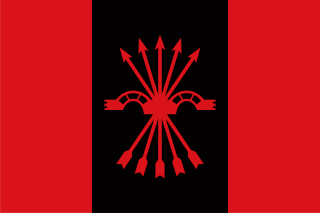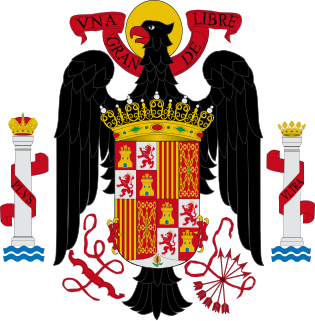
The Falange Española de las Juntas de Ofensiva Nacional Sindicalista, was a fascist political party founded in 1934 as merger of the Falange Española and the Juntas de Ofensiva Nacional-Sindicalista. The Falange Española de las JONS, which became the main Fascist group during the Second Spanish Republic, ceased to exist as such when, during the Civil War, General Francisco Franco merged it with the Traditionalist Communion in April 1937 to form the similarly named Falange Española Tradicionalista y de las JONS, which became the sole legal party in Spain until its dissolution in 1977.

Francoist Spain, known in Spain as the Francoist dictatorship, was the period of Spanish history between 1936 and 1975, when Francisco Franco ruled Spain with the title Caudillo. After his death in 1975, Spain transitioned into a democracy. During this time period Spain was officially known as the Spanish State.

Falangism was the political ideology of two political parties in Spain that were known as the Falange, namely first the Falange Española de las Juntas de Ofensiva Nacional Sindicalista and afterwards the Falange Española Tradicionalista y de las Juntas de Ofensiva Nacional Sindicalista. Falangism has a disputed relationship with fascism as some historians consider the Falange to be a fascist movement based on its fascist leanings during the early years, while others focus on its transformation into an authoritarian conservative movement in Francoist Spain.

The Falange Española Tradicionalista y de las Juntas de Ofensiva Nacional Sindicalista, frequently shortened to just "FET", was the sole legal party of the Francoist regime in Spain. It was created by General Francisco Franco in 1937 as a merger of the Carlist, monarchist, and ultracatholic Traditionalist Communion with the fascist Falange Española de las JONS. In addition to the resemblance of names, the party formally retained most of the platform of FE de las JONS and a similar inner structure. In force until April 1977, it was rebranded as Movimiento Nacional in 1958.

The Nationalist faction or Rebel faction was a major faction in the Spanish Civil War of 1936 to 1939. It was composed of a variety of right-leaning political groups that supported the Spanish Coup of July 1936 against the Second Spanish Republic and Republican faction and sought to depose Manuel Azaña, including the Falange, the CEDA, and two rival monarchist claimants: the Alfonsist Renovación Española and the Carlist Traditionalist Communion. In 1937, all the groups were merged into the FET y de las JONS. One of the members of the 1936 coup, General Francisco Franco, would after the death of the faction's earlier leaders head the Nationalists throughout most of the war and emerge as the dictator of Spain until 1975.

The Sección Femenina was the women's branch of the Falange political movement in Spain. Founded in July 1934 as part of the Sindicato Español Universitario (SEU) of the Falange Española de las JONS, and fully incorporated to FE de las JONS later in the year, it remained as part of the FET y de las JONS following the 1937 Unification Decree, subsequently becoming an official institution of the single-party of the Francoist dictatorship. Following General Franco's death and the beginning of the transition to democracy it was disbanded on 1 April 1977 together with all Movimiento Nacional institutions. Sección Femenina was led throughout its history by Pilar Primo de Rivera, the younger sister of Falange Española founder José Antonio Primo de Rivera.
Women on the Nationalist side of the Spanish Civil War came from a culture and historical background that traditionally saw the role of women being defined by the Catholic Church. Prior to the founding of the Second Republic, women had few rights and were often under the control of their fathers or husbands. Their role in the state was to be a good mother, and the framework of the state supported that. They had few employment opportunities, were largely illiterate and their children often died during childbirth. Political activism was often based around Catholic organized women's groups. The Dictatorship of Primo de Rivera saw women enlisted on electoral rolls for the first time, as well as being allowed to run for municipal political office and appointed to the national congress by 1927.
Motherhood in the Spanish Civil War period was a political concept around the idea of women's involvement in support of the state. The blending of definitions of motherhood and womanhood had been occurring in Spain long before this though, with a woman's role being defined as being in the house part of a biological determinism perspective supported by male run institutions in Spain, including the Government and the Catholic Church.
Women in Francoist Spain found traditional Catholic Spanish gender roles being imposed on them, in terms of their employment opportunities and role in the family. For Republican women, Francoist Spain was a double loss, as the new regime first took away the limited political power and identities as women which they had won during the Second Spanish Republic (1931-1939), and it secondly forced them back into the confines of their homes. Motherhood would become the primary social function of women in Francoist Spain.

Women in the workforce in Francoist Spain faced high levels of discrimination. The end of the Spanish Civil War saw a return of traditional gender roles in the country. These were enforced by the regime through laws that regulated women's labor outside the home and the return of the Civil Code of 1889 and the former Law Procedure Criminal, which treated women as legally inferior to men. During the 1940s, women faced many obstacles to entering the workforce, including financial penalties for working outside the home, job loss upon marriage and few legally available occupations.
Women rights in Francoist Spain (1939–1975) and the democratic transition (1975–1985) were limited. The Franco regime immediately implemented draconian measures that legally incapacitated women, making them dependents of their husbands, fathers or the state. Moderate reforms would not begin until the 1960s, with more dramatic reforms taking place after Franco's death in 1975 and the ensuing democratic transition.
Motherhood in Francoist Spain was the definition of being a woman. Motherhood was important to the state because Hispanic eugenics saw women's bodies as state property. They were needed to rebuild Spain by creating a race of people aligned with the prevailing Catholic morality of the period. The regime then created numerous laws to enforce its vision of motherhood. These would not begin to relax until the late 1950s, and only face radical changes in the post-Franco period.
Feminism in Francoist Spain and the democratic transition period took place in a specific socio-historical context. Spanish feminism went through several waves in the Francoist period. Broadly speaking, they are first-wave feminism taking place from the mid-nineteenth century to 1965, second-wave feminism taking place from 1965 to 1975, and third-wave feminism taking place from 1975 to 2012.
Women in Partido Comunista de España in Francoist Spain faced many challenges. Partido Comunista de España (PCE) had been made illegal by the new regime, which banned all political parties and trade unions. In the final days of the Civil War and during the first days of Francoist Spain, women were imprisoned just for being related to "reds". They were also investigated, harassed, imprisoned and executed for expressing sympathy for Republicans or belonging to any leftist organization. Many women in PCE were caught up in this. PCE women's organization Agrupación de Mujeres Antifascistas survived the war, and shifted their priorities to assisting political prisoners in Francost jails.
Women in POUM in Francoist Spain were few as many, along with male dominated leadership, were forced into exile following the end of the Spanish Civil War. Those in exile often felt isolated and alone. Those who remained were sometimes sent to prison. POUM women participated in a hunger strike at Madrid's Las Ventas prison in 1946. The group fell by the wayside as Partido Comunista de España became the pre-dominant resistance organization in Spain. The organization finally dissolved during the 1950s in Toulouse, France with its memory kept alive by the wife of its last president, María Teresa Carbone, through the Fundació Andreu Nin.

Women's education in Francoist Spain was based around the belief that women lacked the same intellectual abilities as men and that education should prepare women for lives in the home as wives and mothers.
Women in CNT in Francoist Spain were persecuted as part of state organized efforts to eliminate remaining leftist elements. Confederación Nacional del Trabajo (CNT) was formed in 1910, and from the onset it did not treat women equally to men inside the organization. This continued during the Second Spanish Republic, the Spanish Civil War and into Francoist Spain.

Childcare in Francoist Spain and the democratic transition was not about the needs of the mother, but about the needs of the state to educate children. While childcare centers had been provided by Republican aligned unions in the Spanish Civil Wars, with the start of the Franco period women were discouraged from participating in the workforce. Instead, they were expected to tend to their children in the home. The 1942 Ley de Sanidad Infantil y Maternal provided some assistance to working mothers, including maternity leave, economic incentives to breastfeed and infant childcare. By 1955, the Franco government offered educational programming for children aged three to five, but this was focused less on the needs of mothers for childcare and more on the desire to provide children with skills and abilities to succeed in later mandatory schooling. By 1970, children aged two to five were officially considered part of the educational system, even if attendance was not mandatory.

Women's suffrage in Francoist Spain and the democratic transition was constrained by age limits, definitions around heads of household and a lack of elections. Women earned the right to vote in Spain in 1933 as a result of legal changes made during the Second Spanish Republic. Women lost most of their rights after Franco came to power in 1939 at the end of the Spanish Civil War, with the major exception that women did not universally lose their right to vote. Repression of the women's vote occurred nevertheless as the dictatorship held no national democratic elections between 1939 and 1977.

Gender violence and rape in Francoist Spain was a problem that was a result of Nationalist attitudes developed during the Spanish Civil War. Sexual violence was common on the part of Nationalist forces and their allies during the Civil War. Falangist rearguard troops would rape and murder women in cemeteries, hospitals, farmhouses, and prisons. They would rape, torture and murder socialists, young girls, nurses and milicianas. Regular Nationalist soldiers engaged in similar patterns of rape, torture and murder in places like Maials, Callus and Cantalpino. Moroccan Foreign Legionaries were used to commit rape against women to instil terror among local populaces, using rape as a weapon of war. Women in prison were also raped, often facing death if they refused to have sex with their captors. The exact extent of the problem will likely never be known as there was less record keeping around women, and quantification attempts have largely resulted in the erasure of women's history.






